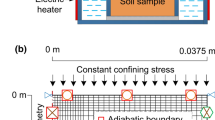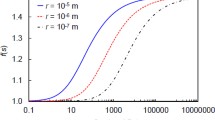Abstract
Based on a non-equilibrium thermodynamic approach, this paper has established a constitutive model for saturated soils different from the classical elasto-plastic model and other thermodynamics-based models. It does not require concepts such as yield surface and flow rule. Instead, through a quantitative description of the energy in the reversible and irreversible processes in materials, the constitutive relations have been obtained theoretically. Using the elastic potential energy function, the stress is expressed as a function of elastic strain. By introducing the granular entropy and locked energy concepts, the non-elastic strain evolution is determined according to the non-equilibrium thermodynamics. The model can describe many basic mechanical properties of saturated soils under monotonic and cyclic shear loadings, such as the stress state boundary, the critical state and especially the cyclic mechanical behavior. Based on this model, the paper simulates the cyclic undrained triaxial shear tests for saturated clays and analyzes the impact of factors that include cyclic stress ratio, OCR value and cyclic stress frequency. The simulation results are compared with experimental results in order to validate the model.

















Similar content being viewed by others
References
Acharya A, Shawki TG (1995) Thermodynamic restrictions on constitutive equations for second-deformation-gradient inelastic behavior. J Mech Phys Solids 43(11):1722–1751
Andrew JW, Michael J et al (1994) Formulation of MIT-E3 constitutive model for overconsolidated clays. J Geotech Eng 120(1):173–198
Bardet JP (1986) A bounding surface model for sands. J Eng Mech Div ASCE 112(11):1198–1216
Bjerrum L (1966) Progressive failure in slopes of overconsolidated plastic clay shales. The Terzhagi lectures, 1963–1972. American Society of Civil Engineers, New York (1974)
Bjerrum L (1973) Geotechnical problems involved in foundations of structures in the North Sea. Geotechnique 23(3):319–358
Chen WF et al (2005) Elasticity and plasticity. China Architecture & Building Press, Beijing
Coleman BD, Gurtin ME (1967) Thermodynamics with internal state variables. J Gem Phys 47:597–613
Collins IF (2005) The concept of stored plastic work of frozen elastic energy in soil mechanics. Geotechnique 55(5):373–382
Collins IF, Hilder T (2002) A theoretical framework for constructing elastic/plastic constitutive models for triaxial tests. Int J Numer Anal Methods Geomech 26(13):1313–1347
Coussy O (1995) Mechanics of porous continua. Wiley, Chichester
Dafalias YF (1987) An anisotropic critical state clay plasticity model. Const Laws Eng Mater Theory Appl 12:513–521
Dayakar P, Arumugam S et al (1998) Strain-rate effects in pressuremeter testing using a cuboidal shear device: experiments and modeling. Can Geotech 35:27–42
Fuentes W, Triantafyllidis T, Lizcano A (2012) Hypoplastic model for sands with loading surface. Acta Geotech 7:177–192
Gennaro VD, Canou J et al (2004) Influence of loading path on the undrained behaviour of a medium loose sand. Can Geotech J 41:166–180
Groot SR, Mazur P (1962) Non-Equilibrium thermodynamics. North-Holland Pub. Co, Amsterdam
Hardin BO, Drnevich VP (1972) Shear modulus and damping in soils: measurement and parameters effects. J Soil Mech Found Div ASCE 98(6):603–624
Houlsby GT (1981) A study of plasticity theories and their application to soils. Dissertation, University of Cambridge
Houlsby GT (1981) A study of plasticity theories and their application to soils. PhD thesis, University of Cambridge
Houlsby GT (1985) The use of a variable shear modulus in elastic–plastic models for clays. Comput Geotech 1:3–13
Houlsby GT, Puzrin AM (2006) Principles of hyperplasticity: an approach to plasticity theory based on thermodynamic principles. Springer, London
Jefferies M (1997) Plastic work and isotropic hardening in unloading. Geotechnique 47(5):1037–1042
Jiang YM, Liu M (2003) Granular elasticity without the coulomb condition. Phys Rev Lett 91:144301
Jiang YM, Liu M (2004) Energetic instability unjams sand and suspension. Phys Rev Lett 93:148001
Jiang YM, Liu M (2007) From elasticity to hypoplasticity: dynamics of granular solids. Phys Rev Lett 99:105501
Jiang YM, Liu M (2009) Granular solid hydrodynamics. Granul Matter 11(3):139–156
Jiang YM, Liu M (2013) Hydrodynamic theory of grains, water and air. Acta Phys Sin 62(20):204501
Kenny KS, Beatrice AB, Tatsuoka F (2006) Coupling of ageing and viscous effects in an artificially structured clay. In: Geotechnical symposium in Roma, pp 357–366
Laloui L, Cekerevac C (2008) Non-isothermal plasticity model for cyclic behaviour of soils. Int J Numer Anal Methods Geomech 32:437–460
Landau LD, Lifshitz EM (1986) Theory of elasticity, 3rd edn. Pergamon Press, Oxford
Landau LD, Lifshitz EM (1987) Fluid mechanics, 2nd edn. Pergamon Press, Oxford
Liu M (1995) Fluid dynamics of colloidal magnetic and electric liquid. Phys Rev Lett 74:4535–4538
Liu M (1998) Rotating superconductors and the frame-independent London equation. Phys Rev Lett 81:3223–3226
Martin PC, Parodi O, Pershan PS (1972) Unified hydrodynamic theory for crystals, liquid crystals, and normal fluids. Phys Rev A 6(6):2401–2420
Onsager L (1931) Reciprocal relations in irreversible processes. Phys Rev 37:405–426
Palmer AC (1967) Stress–strain relations for clays: an energy theory. Geotechnique 17(4):348–358
Prevost JH (1978) Anisotropic undrained stress–strain behavior of clays. J Geotech Eng Div ASCE 104(8):1075–1090
Rice JR (1971) Inelastic constitutive relations for solids: an internal-variable theory and its application to metal plasticity. J Mech Phys Solids 19:433–455
Salciarini D, Tamagnini C (2009) A hypoplastic macroelement model for shallow foundations under monotonic and cyclic loads. Acta Geotech 4:163–176
Teachavorasinskun S, Lukkanaprasit P (2008) Stress induced and inherent anisotropy on elastic stiffness of soft clays. Soils Found 48(1):127–132
Wang J (2007) Study on dynamic behavior of saturated soft clay under unidirectional and bidirectional cyclic loading. Dissertation, Zhejiang University
Yan WM, Li XS (2011) A model for natural soil with bonds. Geotechnique 61(2):95–106
Yin ZY, Xu Q, Hicher PY (2013) A simple critical-state-based double-yield-surface model for clay behavior under complex loading. Acta Geotech 8:509–523
Zhang ZC, Cheng XH (2013) Effective stress in saturated soil: a granular solid hydrodynamics approach. Granul Matter 16:761–769
Ziegler H (1983) An introduction to thermomechanics, 2nd edn. Noah Holland, Amsterdam
Acknowledgments
This study was supported by the Tsinghua-Cambridge-MIT Low Carbon Energy University Alliance (TCM-LCEUA) seed funding project, to which we hereby express our sincere gratitude.
Author information
Authors and Affiliations
Corresponding author
Appendices
Appendix 1: Main parameters used in the proposed model
Parameter type | Elastic potential energy density function parameters | Migration coefficient | Hysteric parameters | |||
|---|---|---|---|---|---|---|
B 0/Pa | B 1/(m3/kg) | c/[-] | m 1/[−] | m 2/min−(1−2a)/a | h/[−] | |
ξ/[−] | ζ/[−] | m 3/[−] | m 4/(kg/m3/min) | w/[−] | ||
Hangzhou Clay | 31.2 | 0.0123 | 0.0203 | 15 | 920.6 | 0.036 |
0.276 | 0.0534 | 3 × 10−3 | 6 × 103 | 0.96 | ||
Kaolin Clay | 2.35 × 106 | 0.00438 | 0.0282 | 4.44 | 1088 | 0.0205 |
0.194 | 0.0445 | – | 1.4 × 104 | 0.96 | ||
MC Clay | 6.59 × 107 | 0.00438 | 0.00754 | 51 | 691 | 0.01 |
0.0426 | 0.0082 | – | 3.2 × 103 | 0.72 | ||
Appendices 2: Model parameter calibration procedure
In this paper, the main model parameters include the following categories. The relevant parameters of the elastic potential energy density function (Eq. (17)) are B 0, B 1, c, ξ and ζ; the migration coefficients are m 1, m 2, m 3 and m 4 (see Eq. (24)); the hysteresis-related parameters are h and w; the rate-related parameter is a. The calibration processes of these parameters are briefly described below.
-
1.
First, the critical state line in e–p ′–q space (Fig. 7) is determined using two groups of undrained triaxial tests with constant strain rates, which can be used to determine the parameters B 1. For a isotropically consolidated state with a confining pressure level of p′ 0 as,
$$ p_{0}^{{\prime }} = 0.6B_0\times\exp(B_1\times p_{d0})(\varepsilon_{v0}^{e} + c)^{0.5} \varepsilon_{v0}^{e2} + 0.8B_0\times\exp(B_1\times p_{d0})(\varepsilon_{v0}^{e} + c)^{1.5} \varepsilon_{v0}^{e} $$(31)where ρ d0 and \( \varepsilon_{v0}^{e} \) are the corresponding dry density and elastic volumetric strain, respectively. \( \varepsilon_{v0}^{e} \) can be estimated by rebound test (i.e., the unloading of consolidation pressure). Then, using Eqs. (29 and 31), parameters B 0 and c can be obtained.
From Eq. (25b), the ratio of the absolute value of undrained critical shear strength of triaxial compression to that of triaxial extension under the same axial strain rate is
According to the undrained triaxial compression test with a constant strain rate under the confining pressure p′ 0, the critical effective stresses q cr and p′ cr can be obtained. Using triaxial tensile test with the same strain rate, the critical strength ratio of the compression path and extension path can also be obtained. Then, using Eqs. (25, 30 and 32), parameters ξ, ζ and the deviatoric elastic strain in critical state (\( \left| {(\varepsilon_{d}^{e} )_{cr} } \right| \)) can be calculated.
-
2.
Parameter h can be determined according to h = 0.6\( \left| {(\varepsilon_{d}^{e} )_{cr} } \right| \). Using Eq. (30c), the value of parameter m 2 can be determined (axial strain rate d t ε 1 is given by tests). Keeping the calibrated parameters above unchanged, adjusting the values of m 1 and m 4 can adjust the stress–strain relation curve before reaching critical state. Accordingly, m 1 and m 4 can be calibrated. Equation (24) suggests that parameter m 3 is related to isotropic consolidation, but have no direct relation to undrained shear processes (because d t ε v = 0). The value of parameter m 3 can thus be calibrated using the isotropic consolidation curve. When calibrating the consolidation curve for over-consolidated soil, the initial locked strain value should be adjusted to adjust the position of the pre-consolidation pressure.
-
3.
Parameter a, related to rate dependency, can be calibrated using the critical strength values of triaxial undrained compression tests under different shear rates and the same confining pressure. This paper recommends that, for the most of cohesive soils, the a value be set to be about 0.45.
Rights and permissions
About this article
Cite this article
Zhang, Z., Cheng, X. A thermodynamic constitutive model for undrained monotonic and cyclic shear behavior of saturated soils. Acta Geotech. 10, 781–796 (2015). https://doi.org/10.1007/s11440-015-0389-5
Received:
Accepted:
Published:
Issue Date:
DOI: https://doi.org/10.1007/s11440-015-0389-5




